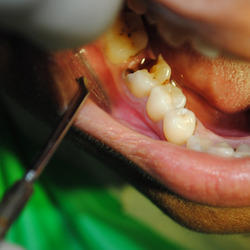

There are many reasons why your dentist would extract a tooth. An extraction may come as the result of severe tooth decay or disease, gum disease, fractured teeth, or in preparation for braces. There are two types of extractions that your dentist may have perform. The first extraction your doctor might perform is a non-surgical extraction which involves tools known as “elevators” and “forceps”, takes place while the patient is under anesthetic, and when the tooth is visible in the mouth. The second extraction your dentist may have to perform is a surgical extraction, which is also performed while the patient is under anaesthetic. However surgical removal differs in that the tooth is not visible and that an incision has to be made for the tooth to come out.
-Simple Extraction: A simple tooth extraction is done under local anaesthesia. As the name implies, the tooth comes out fairly easy. The tooth is gently elevated out of the jaw bone and a blood clot forms within several minutes.
-Surgical Extraction: A surgical extraction is when there is not much visible tooth exposed. This type of extraction is typically preformed under local anaesthesia. Sometimes general anaesthesia is required. With a Surgical extraction bone and gum is typically removed to expose the tooth for removal.